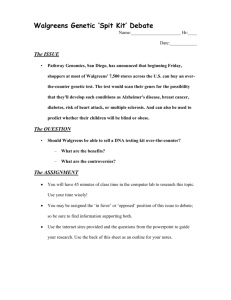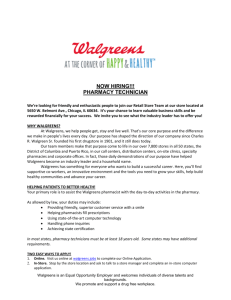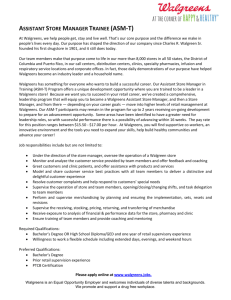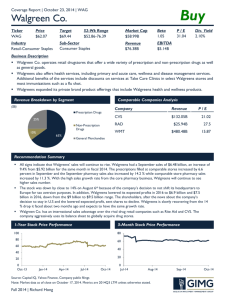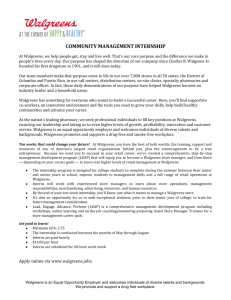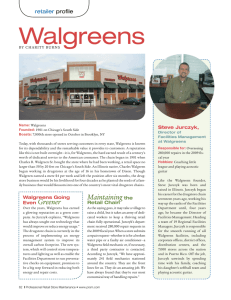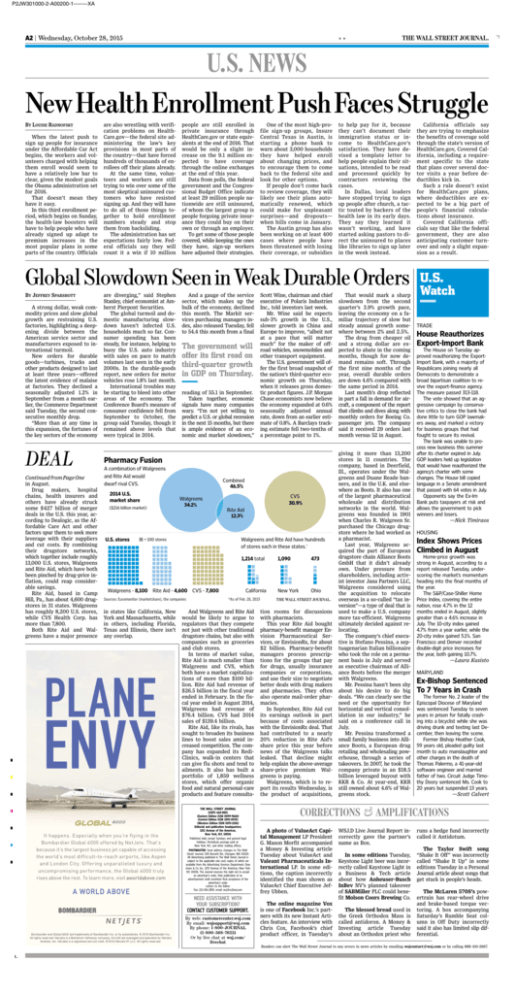
P2JW301000-2-A00200-1--------XA
A2 | Wednesday, October 28, 2015
* *
THE WALL STREET JOURNAL.
U.S. NEWS
NewHealthEnrollmentPushFacesStruggle
BY LOUISE RADNOFSKY
When the latest push to
sign up people for insurance
under the Affordable Car Act
begins, the workers and volunteers charged with helping
them enroll would seem to
have a relatively low bar to
clear, given the modest goals
the Obama administration set
for 2016.
That doesn’t mean they
have it easy.
In this third enrollment period, which begins on Sunday,
the health-law boosters will
have to help people who have
already signed up adapt to
premium increases in the
most popular plans in some
parts of the country. Officials
are also wrestling with verification problems on HealthCare.gov—the federal site administering the law’s key
provisions in most parts of
the country—that have forced
hundreds of thousands of enrollees off their plans already.
At the same time, volunteers and workers are still
trying to win over some of the
most skeptical uninsured customers who have resisted
signing up. And they will have
to do all of those things together to hold enrollment
numbers steady and stop
them from backsliding.
The administration has set
expectations fairly low. Federal officials say they will
count it a win if 10 million
people are still enrolled in
private insurance through
HealthCare.gov or state equivalents at the end of 2016. That
would be only a slight increase on the 9.1 million expected to have coverage
through the online exchanges
at the end of this year.
Data from polls, the federal
government and the Congressional Budget Office indicate
at least 29 million people nationwide are still uninsured,
of whom the largest group is
people forgoing private insurance they could buy on their
own or through an employer.
To get some of those people
covered, while keeping the ones
they have, sign-up workers
have adjusted their strategies.
One of the most high-profile sign-up groups, Insure
Central Texas in Austin, is
starting a phone bank to
warn about 3,000 households
they have helped enroll
about changing prices, and
to encourage them to come
back to the federal site and
look for other options.
If people don’t come back
to review coverage, they will
likely see their plans automatically renewed, which
could make for unpleasant
surprises—and dropouts—
when bills come in January.
The Austin group has also
been working on at least 400
cases where people have
been threatened with losing
their coverage, or subsidies
to help pay for it, because
they can’t document their
immigration status or income to HealthCare.gov’s
satisfaction. They have devised a template letter to
help people explain their situations, intended to be read
and processed quickly by
contractors reviewing the
cases.
In Dallas, local leaders
have stopped trying to sign
up people after church, a tactic touted by backers of the
health law in its early days.
They say they learned it
wasn’t working, and have
started asking pastors to direct the uninsured to places
like libraries to sign up later
in the week instead.
Global Slowdown Seen in Weak Durable Orders
BY JEFFREY SPARSHOTT
A strong dollar, weak commodity prices and slow global
growth are restraining U.S.
factories, highlighting a deepening divide between the
American service sector and
manufacturers exposed to international turmoil.
New orders for durable
goods—turbines, trucks and
other products designed to last
at least three years—offered
the latest evidence of malaise
at factories. They declined a
seasonally adjusted 1.2% in
September from a month earlier, the Commerce Department
said Tuesday, the second consecutive monthly drop.
“More than at any time in
this expansion, the fortunes of
the key sectors of the economy
DEAL
Continued from Page One
in August.
Drug makers, hospital
chains, health insurers and
others have already struck
some $427 billion of merger
deals in the U.S. this year, according to Dealogic, as the Affordable Care Act and other
factors spur them to seek more
leverage with their suppliers
and cut costs. By combining
their drugstore networks,
which together include roughly
13,000 U.S. stores, Walgreens
and Rite Aid, which have both
been pinched by drug-price inflation, could reap considerable savings.
Rite Aid, based in Camp
Hill, Pa., has about 4,600 drugstores in 31 states. Walgreens
has roughly 8,200 U.S. stores,
while CVS Health Corp. has
more than 7,800.
Both Rite Aid and Walgreens have a major presence
are diverging,” said Stephen
Stanley, chief economist at Amherst Pierpont Securities.
The global turmoil and domestic manufacturing slowdown haven’t infected U.S.
households much so far. Consumer spending has been
steady, for instance, helping to
buoy the U.S. auto industry
with sales on pace to match
volumes last seen in the early
2000s. In the durable-goods
report, new orders for motor
vehicles rose 1.8% last month.
International troubles may
be starting to bleed into other
areas of the economy. The
Conference Board’s measure of
consumer confidence fell from
September to October, the
group said Tuesday, though it
remained above levels that
were typical in 2014.
And a gauge of the service
sector, which makes up the
bulk of the economy, declined
this month. The Markit services purchasing managers index, also released Tuesday, fell
to 54.4 this month from a final
The government will
offer its first read on
third-quarter growth
in GDP on Thursday.
reading of 55.1 in September.
Taken together, economic
signals have many companies
wary. “I’m not yet willing to
predict a U.S. or global recession
in the next 15 months, but there
is ample evidence of an economic and market slowdown,”
Scott Wine, chairman and chief
executive of Polaris Industries
Inc., told investors last week.
Mr. Wine said he expects
sub-3% growth in the U.S.,
slower growth in China and
Europe to improve, “albeit not
at a pace that will matter
much” for the maker of offroad vehicles, snowmobiles and
other transport equipment.
The U.S. government will offer the first broad snapshot of
the nation’s third-quarter economic growth on Thursday,
when it releases gross domestic product figures. J.P. Morgan
Chase economists now believe
the economy expanded at 0.6%
seasonally adjusted annual
rate, down from an earlier estimate of 0.8%. A Barclays tracking estimate fell two-tenths of
a percentage point to 1%.
Pharmacy Fusion
A combination of Walgreens
and Rite Aid would
dwarf rival CVS.
2014 U.S.
market share
($216 billion market)
U.S. stores
Combined
46.5%
Walgreens
34.2%
CVS
30.9%
Rite Aid
12.3%
Walgreens and Rite Aid have hundreds
of stores each in these states.*
= 100 stores
1,214 total
Walgreens - 8,100 Rite Aid - 4,600 CVS - 7,800
Sources: Euromonitor (marketshare), the companies
in states like California, New
York and Massachusetts, while
in others, including Florida,
Texas and Illinois, there isn’t
any overlap.
It happens. Especially when you’re flying in the
Bombardier Global 6000 offered by NetJets. That’s
because it’s the largest business jet capable of accessing
the world’s most difficult-to-reach airports, like Aspen
and London City. Offering unparalleled luxur y and
uncompromising performance, the Global 6000 truly
rises above the rest. To learn more, visit aworldabove.com
California
*As of Feb. 28, 2015
And Walgreens and Rite Aid
would be likely to argue to
regulators that they compete
not just with other traditional
drugstore chains, but also with
companies such as groceries
and club stores.
In terms of market value,
Rite Aid is much smaller than
Walgreens and CVS, which
both have a market capitalizations of more than $100 billion. Rite Aid had revenue of
$26.5 billion in the fiscal year
ended in February. In the fiscal year ended in August 2014,
Walgreens had revenue of
$76.4 billion. CVS had 2014
sales of $139.4 billion.
Rite Aid, like its rivals, has
sought to broaden its business
lines to boost sales amid increased competition. The company has expanded its RediClinics, walk-in centers that
can give flu shots and tend to
ailments. It also has built a
portfolio of 1,859 wellness
stores, which offer organic
food and natural personal-care
products and feature consultaTHE WALL STREET JOURNAL
(USPS 664-880)
(Eastern Edition ISSN 0099-9660)
(Central Edition ISSN 1092-0935)
(Western Edition ISSN 0193-2241)
Editorial and publication headquarters:
1211 Avenue of the Americas,
New York, N.Y. 10036
Published daily except Sundays and general legal
holidays. Periodicals postage paid at
New York, N.Y., and other mailing offices.
POSTMASTER: Send address changes to The Wall
Street Journal, 200 Burnett Rd., Chicopee, MA 01020.
All Advertising published in The Wall Street Journal is
subject to the applicable rate card, copies of which are
available from the Advertising Services Department, Dow
Jones & Co. Inc., 1155 Avenue of the Americas, New York,
N.Y. 10036. The Journal reserves the right not to accept
an advertiser’s order. Only publication of an
advertisement shall constitute final acceptance of the
advertiser’s order.
Letters to the Editor:
Fax: 212-416-2891; email: wsj.ltrs@wsj.com
NEED ASSISTANCE WITH
YOUR SUBSCRIPTION?
CONTACT CUSTOMER SUPPORT.
Bombardier and Global 6000 are trademarks of Bombardier Inc. or its subsidiaries. © 2015 Bombardier Inc.
All rights reserved. NetJets is a Berkshire Hathaway company. Aircraft are managed and operated by NetJets
Aviation, Inc. NetJets is a registered service mark. © 2015 NetJets IP, LLC. All rights reserved.
By web: customercenter.wsj.com
By email: wsjsupport@wsj.com
By phone: 1-800-JOURNAL
(1-800-568-7625)
Or by live chat at wsj.com/
livechat
1,090
473
New York
Ohio
THE WALL STREET JOURNAL.
tion rooms for discussions
with pharmacists.
This year Rite Aid bought
pharmacy-benefit manager Envision Pharmaceutical Services, or EnvisionRx, for about
$2 billion. Pharmacy-benefit
managers process prescriptions for the groups that pay
for drugs, usually insurance
companies or corporations,
and use their size to negotiate
better deals with drug makers
and pharmacies. They often
also operate mail-order pharmacies.
In September, Rite Aid cut
its earnings outlook in part
because of costs associated
with the EnvisionRx deal. That
had contributed to a nearly
20% reduction in Rite Aid’s
share price this year before
news of the Walgreens talks
leaked. That decline might
help explain the above-average
share-price premium Walgreens is paying.
Walgreens, which is to report its results Wednesday, is
the product of acquisitions,
That would mark a sharp
slowdown from the second
quarter’s 3.9% growth pace,
leaving the economy on a familiar trajectory of slow but
steady annual growth somewhere between 2% and 2.5%.
The drag from cheaper oil
and a strong dollar are expected to abate in the coming
months, though for now demand remains soft. Through
the first nine months of the
year, overall durable orders
are down 4.6% compared with
the same period in 2014.
Last month’s drop reflected
in part a fall in demand for aircraft, a component of the report
that climbs and dives along with
monthly orders for Boeing Co.
passenger jets. The company
said it received 29 orders last
month versus 52 in August.
giving it more than 13,200
stores in 11 countries. The
company, based in Deerfield,
Ill., operates under the Walgreens and Duane Reade banners, and in the U.K. and elsewhere as Boots. It also has one
of the largest pharmaceutical
wholesale and distribution
networks in the world. Walgreens was founded in 1901
when Charles R. Walgreen Sr.
purchased the Chicago drugstore where he had worked as
a pharmacist.
Last year, Walgreens acquired the part of European
drugstore chain Alliance Boots
GmbH that it didn’t already
own. Under pressure from
shareholders, including activist investor Jana Partners LLC,
Walgreens considered using
the acquisition to relocate
overseas in a so-called “tax inversion”—a type of deal that is
used to make a U.S. company
more tax-efficient. Walgreens
ultimately decided against relocating.
The company’s chief executive is Stefano Pessina, a septuagenarian Italian billionaire
who took the role on a permanent basis in July and served
as executive chairman of Alliance Boots before the merger
with Walgreens.
Mr. Pessina hasn’t been shy
about his desire to do big
deals. “We can clearly see the
need or the opportunity for
horizontal and vertical consolidation in our industry,” he
said on a conference call in
July.
Mr. Pessina transformed a
small family business into Alliance Boots, a European drug
retailing and wholesaling powerhouse, through a series of
takeovers. In 2007, he took the
company private in an $18.5
billion leveraged buyout with
KKR & Co. At year-end, KKR
still owned about 4.6% of Walgreens stock.
California officials say
they are trying to emphasize
the benefits of coverage sold
through the state’s version of
HealthCare.gov, Covered California, including a requirement specific to the state
that plans cover several doctor visits a year before deductibles kick in.
Such a rule doesn’t exist
for HealthCare.gov plans,
where deductibles are expected to be a big part of
people’s financial calculations about insurance.
Covered California officials say that like the federal
government, they are also
anticipating customer turnover and only a slight expansion as a result.
U.S.
Watch
TRADE
House Reauthorizes
Export-Import Bank
The House on Tuesday approved reauthorizing the ExportImport Bank, with a majority of
Republicans joining nearly all
Democrats to demonstrate a
broad bipartisan coalition to revive the export-finance agency.
The measure passed 313-118.
The vote showed that an aggressive campaign by conservative critics to close the bank had
done little to turn GOP lawmakers away, and marked a victory
for business groups that had
fought to secure its revival.
The bank was unable to process new business this summer
after its charter expired in July.
GOP leaders held up legislation
that would have reauthorized the
agency’s charter with some
changes. The House bill copied
language in a Senate amendment
that passed with 64 votes in July.
Opponents say the Ex-Im
Bank puts taxpayers at risk and
allows the government to pick
winners and losers.
—Nick Timiraos
HOUSING
Index Shows Prices
Climbed in August
Home-price growth was
strong in August, according to a
report released Tuesday, underscoring the market’s momentum
heading into the final months of
the year.
The S&P/Case-Shiller Home
Price Index, covering the entire
nation, rose 4.7% in the 12
months ended in August, slightly
greater than a 4.6% increase in
July. The 10-city index gained
4.7% from a year earlier, while the
20-city index gained 5.1%. San
Francisco and Denver recorded
double-digit price increases for
the year, both gaining 10.7%.
—Laura Kusisto
MARYLAND
Ex-Bishop Sentenced
To 7 Years in Crash
The former No. 2 leader of the
Episcopal Diocese of Maryland
was sentenced Tuesday to seven
years in prison for fatally crashing into a bicyclist while she was
driving drunk and texting last December, then leaving the scene.
Former Bishop Heather Cook,
59 years old, pleaded guilty last
month to auto manslaughter and
other charges in the death of
Thomas Palermo, a 41-year-old
software engineer and married
father of two. Circuit Judge Timothy Doory sentenced Ms. Cook to
20 years but suspended 13 years.
—Scott Calvert
CORRECTIONS AMPLIFICATIONS
A photo of ValueAct Capital Management LP President
G. Mason Morfit accompanied
a Money & Investing article
Tuesday about ValueAct and
Valeant Pharmaceuticals International LP. In some editions, the caption incorrectly
identified the man shown as
ValueAct Chief Executive Jeffrey Ubben.
The online magazine Vox
is one of Facebook Inc.’s partners with its new Instant Articles feature. An interview with
Chris Cox, Facebook’s chief
product officer, in Tuesday’s
WSJ.D Live Journal Report incorrectly gave the partner’s
name as Box.
In some editions Tuesday,
Keystone Light beer was incorrectly called Kaystone Light in
a Business & Tech article
about how Anheuser-Busch
InBev NV’s planned takeover
of SABMiller PLC could benefit Molson Coors Brewing Co.
The blessed bread used in
the Greek Orthodox Mass is
called antidoron. A Money &
Investing article Tuesday
about an Orthodox priest who
runs a hedge fund incorrectly
called it Antidotum.
The Taylor Swift song
“Shake It Off” was incorrectly
called “Shake It Up” in some
editions Tuesday in a Personal
Journal article about songs that
get stuck in people’s heads.
The McLaren 570S’s powertrain has rear-wheel drive
and brake-based torque vectoring. A box accompanying
Saturday’s Rumble Seat column in Off Duty incorrectly
said it also has limited slip differential.
Readers can alert The Wall Street Journal to any errors in news articles by emailing wsjcontact@wsj.com or by calling 888-410-2667.

